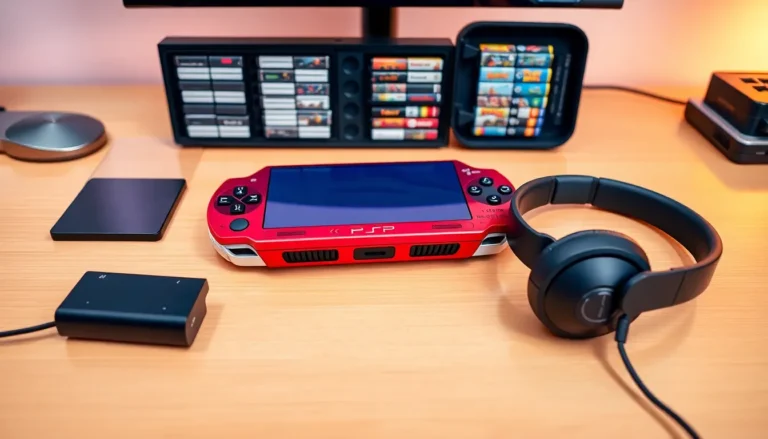Table of Contents
ToggleIn a world where gaming was often about serious competition and high-definition graphics, the Nintendo Wii burst onto the scene like a confetti cannon at a dull party. Launched in 2006, this quirky console redefined how people interacted with video games. Gone were the days of couch potatoes; it invited players to get up, move around, and shake their groove thing.
Overview of the Nintendo Wii
The Nintendo Wii launched in 2006, marking a significant shift in the gaming industry. It prioritized accessibility and inclusivity, appealing to a broad audience, including families and non-gamers. This approach transformed how individuals interacted with video games. Players utilized motion controls, enhancing immersion and engagement in gameplay experiences.
Its innovative design featured a wireless motion-sensing controller, allowing precise input through physical movements. Traditionally, gaming involved sitting still, while the Wii encouraged players to stand and move actively. This change attracted individuals seeking a fun, healthy alternative to sedentary activities.
The Wii’s software library included diverse titles, such as “Wii Sports” and “Mario Kart Wii,” which emphasized group play and social interaction. Multiplayer functionality facilitated friendly competition and cooperation, fostering a sense of community among players. Additionally, the console’s simplistic interface made it easy for users of all ages to navigate.
Nintendo emphasized fitness through its games, introducing titles like “Wii Fit,” which incorporated exercise routines into daily activities. This feature garnered attention from health-conscious consumers, further broadening the console’s appeal. Combined with unique marketing strategies, the Wii achieved massive commercial success, selling over 100 million units globally by the end of its production.
The legacy of the Nintendo Wii continues to influence gaming today. Its focus on physical interaction set a new standard for future consoles, inspiring innovative motion-based technologies across the industry. Several competitors have since incorporated similar features, illustrating the Wii’s lasting impact on gaming culture. Overall, it reshaped perceptions of gaming, making it a more dynamic and engaging experience for everyone.
Release Date and Timeline
The Nintendo Wii launched in 2006, making a significant impact on the gaming industry. Its development journey and official release marked key moments in gaming history.
Development Process
Nintendo began the Wii’s development in 2001, emphasizing innovation and inclusivity. Ideas for motion control and casual gaming emerged early in the design phase. The company aimed to attract a wider audience beyond traditional gamers. Extensive testing revealed that intuitive controls enhanced player engagement. Developers focused on creating a unique gaming experience centered around physical interaction.
Official Launch Date
The official launch of the Nintendo Wii occurred on November 19, 2006, in North America. Europe followed shortly with its release on December 8, 2006. Japan saw the console’s earlier debut on December 2, 2006. The launch generated significant excitement and strong pre-orders. By the end of 2006, sales figures surpassed four million units in North America alone, solidifying its popularity.
Impact on Gaming Industry
The Nintendo Wii revolutionized the gaming industry by offering innovative experiences that appealed to a wide range of players. By promoting physical activity and social interaction, it changed how games were designed and played.
Innovations Introduced
The Wii introduced motion-sensing technology, allowing players to interact with games through physical movements. This innovative approach shifted the focus from traditional controls to intuitive gestures. Additionally, the console featured a wireless controller, enhancing player freedom and reducing clutter. Unique titles like “Wii Sports” demonstrated how gameplay could incorporate family and friends in a shared experience. Engaging fitness games, such as “Wii Fit,” targeted health-conscious consumers by making exercise entertaining. Accessibility stood out as a core principle, drawing in casual gamers and non-gamers alike. Overall, these advancements set a new benchmark for interactivity in gaming.
Sales Performance
Sales figures highlighted the Wii’s commercial success, with over 100 million units sold worldwide. By the end of 2006, sales exceeded four million units in North America alone. The initial launch sparked a frenzy, leading to long lines at retail stores. Consistent hardware availability fueled sustained interest throughout the subsequent years. Competitive pricing gave it an edge over rival consoles, appealing to budget-conscious consumers. Strong demand for popular titles ensured that its software library expanded rapidly. The Wii’s impressive sales trajectory solidified its place as one of the best-selling consoles in history, cementing its impact on the gaming landscape.
Cultural Influence
The Nintendo Wii significantly shaped gaming culture since its release in 2006. It not only transformed gameplay but also encouraged new social dynamics among players.
Popular Games on the Wii
“Wii Sports” became iconic, showcasing the console’s motion-sensing capabilities. This game encouraged family and friend gatherings, fostering friendly competition. “Mario Kart Wii,” another beloved title, supported multiplayer racing, enhancing social interaction. Fitness games like “Wii Fit” appealed to health enthusiasts, blending exercise with gaming. Various genres thrived on the platform, including adventure and puzzle games, broadening its appeal beyond traditional gamers.
Legacy in Modern Gaming
Developments inspired by the Wii continue to resonate in today’s gaming industry. Motion controls paved the way for further innovations in virtual reality and augmented reality gaming. Many consoles adopted similar accessibility features, expanding their audiences. The inclusion of intuitive gameplay remains essential in game design, reflecting the successful model established by the Wii. Its achievements in promoting active participation changed perceptions of gamers and gaming niches.
Conclusion
The Nintendo Wii’s launch in 2006 marked a pivotal moment in gaming history. Its innovative approach to gameplay transformed how players interacted with video games, prioritizing physical activity and social engagement. The console’s success not only reshaped the gaming landscape but also created a lasting legacy that continues to influence game design today. By appealing to a diverse audience and fostering community connections, the Wii set a new standard for inclusivity in gaming. Its impact is still felt as modern consoles and games draw inspiration from its revolutionary concepts. The Nintendo Wii will forever be remembered as a game-changer in the industry.






